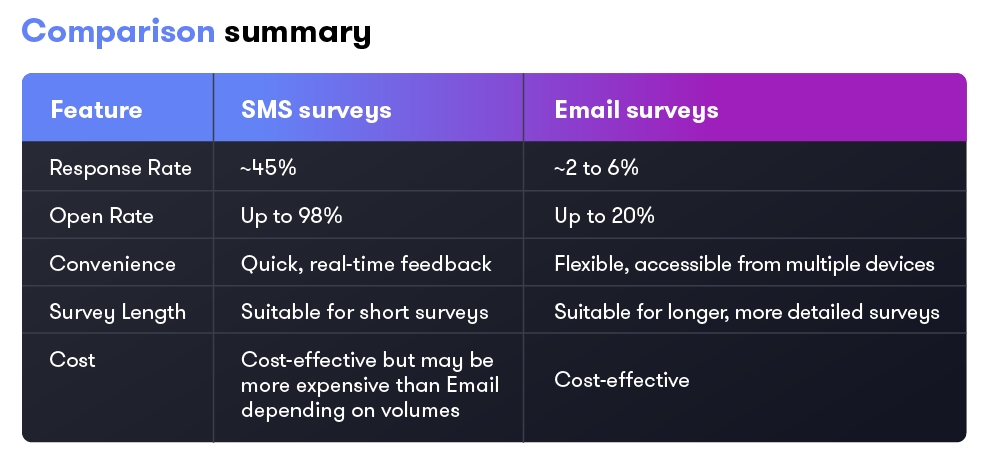GUIDES & PLAYBOOKS
How to get more customers to complete your surveys

Many businesses struggle with low survey response rates, but polling customers is the only way to gather insights about their experiences. Without their input, you’ll be taking shots in the dark.
The right kind of survey—underpinned by a compelling delivery—can go a long way toward collecting more responses.
In this post, we’ll explore strategies for increasing survey response rates, while also considering the strengths and weaknesses of SMS-based surveys and link-in-email surveys based on recent research.
1. Keep it short and focused
Customers are more likely to complete surveys that take under 2 minutes. Add messaging to the SMS or email soliciting customers’ opinions letting them know that this will be very quick.
Once they’re in, avoid anything that can be perceived as lengthy or complex. That applies to the survey itself as well as the questions you’re asking! You can use skip logic to personalize the survey experience based on respondents’ answers and avoid asking any irrelevant or repetitive questions.
Before you begin building out a strategy, be sure to consult our best practices guide.
2. Choose the right moment
Send surveys immediately after the customer interaction to capture fresh, relevant feedback. That might be right after a purchase is made, a service is rendered, or an in-store visit is wrapped up.
Customers may not be ready to engage with your survey right away, so it’s best to send follow-up reminders. Send a couple of gentle nudges to anyone who hasn’t responded, letting them know it’s not too late and you’re still eager to hear from them.
3. Offer an incentive
Sometimes, sweetening the deal makes all the difference. Incentives like bonus loyalty points, discounts, or sweepstakes entries can motivate consumers to participate. You can experiment with different offerings to see which ones resonate most with your audience.
If you want truly unbiased responses, make sure to frame the incentive as a token of appreciation and not a reward for positive feedback
4. Make it mobile-friendly
A large portion of survey responses come from mobile devices, so your surveys should be optimized for easy mobile access. Before you launch, run tests on multiple device types to make sure the experience is optimized across each one.You should also simplify your survey formatting by avoiding text-heavy questions and offer easy-to-select options for quicker completion.
5. Personalize the invitation
Reinforce the relevance of your survey by using the customer’s name and referencing their recent interaction. The more valued the recipient feels, the more likely they’ll be to provide a response.
It’s also a good idea to test different subject lines and invitation formats for both email and SMS surveys to optimize open and response rates.
6. Use multiple channels for distribution
Different customers will prefer different methods of communication, so you’ll need to diversify your approach. Email is a standard distribution channel, but messages can easily get lost in the shuffle and lead to low response rates. Carefully crafted and highly compelling subject lines can rally against these deflated numbers.
SMS is associated with higher open and response rates, especially for short and simple surveys. While this channel is perfect for real-time feedback, it may not be suitable for more complex questionnaires.
QR codes on receipts or in-store signage invite customers to share their feedback right after an in-person experience, while in-app or website pop-ups are great for digital experiences.
7. SMS vs. email surveys: key differences
SMS-based surveys
- SMS response rates are typically around 45%, in large part due to their 98% open rate. Customers tend to open and respond within 90 seconds, making SMS ideal for quick, real-time feedback.

Source: SMS Comparison
- While effective for short surveys, SMS surveys are not ideal for longer, more detailed questionnaires due to screen size constraints and security concerns when clicking external links.
Link-in-email surveys
While email surveys tend to have far lower response rates than SMS, they’re a much better fit for longer, more detailed questionnaires that collect qualitative data. They’re also easy to access across a wider range of devices, including phones, tablets, and computers.

8. Improve survey design & user experience
If respondents feel lost in an endless abyss of questions, they’ll probably navigate away from your survey. Use progress bars to show them how far along they are and include quick select buttons instead of empty text fields. The latter may require you to break complex questions down into smaller, more digestible segments.
9. Communicate the value of feedback
Nobody wants to feel like they’re shouting into the void— so, if possible, let respondents know how their feedback will be used to improve the customer experience. Share examples of past changes that were inspired by real feedback, and thank participants with a follow-up message that summarizes how their thoughts will lead to improvements.
10. Continuously test and refine your approach
Use A/B testing to compare the effectiveness of different survey formats, lengths, and distribution channels. Track drop-off rates to identify pain points in the survey experience and regularly monitor response trends to adjust your strategy accordingly.
No matter the medium, short and sweet surveys are the way to go. Your chosen channel will boil down to your audience demographics and how they typically interact with your brand. Be sure to experiment with both email and SMS to see what resonates—the answer might surprise you!
Want help building an unignorable survey strategy that collects heaps of valuable data? That’s kind of our thing! Learn more about what Chatter can do for your customer experience.